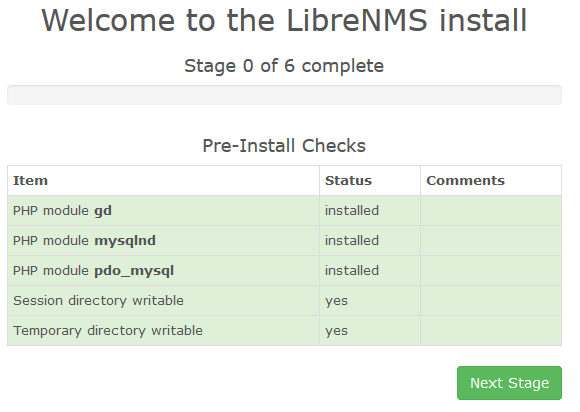How To Install LibreNMS on Ubuntu 24.04 LTS

In this tutorial, we will show you how to install LibreNMS on Ubuntu 24.04 LTS. LibreNMS stands as a powerful, community-driven network monitoring system that provides comprehensive visibility into your network infrastructure. This feature-rich platform offers automated device discovery, detailed performance graphs, customizable alerting, and extensive SNMP support—all through an intuitive web interface. Ubuntu 24.04 LTS (Noble Numbat) serves as an excellent foundation for LibreNMS due to its stability, security features, and long-term support commitment.
This guide walks you through the complete process of installing and configuring LibreNMS on Ubuntu 24.04 LTS, from initial server preparation to adding your first monitored device. By following these instructions, you’ll establish a robust network monitoring solution that provides real-time insights into your infrastructure health.
Prerequisites
Before beginning the LibreNMS installation, ensure your system meets these requirements:
- A server running Ubuntu 24.04 LTS with root or sudo privileges
- Minimum hardware specifications:
- CPU: 2+ cores (4+ recommended for larger networks)
- RAM: 4GB minimum (8GB+ recommended)
- Storage: 40GB+ (SSD recommended for optimal performance)
- Static IP address configured on your server
- Properly configured hostname and DNS settings
- Basic Linux command line experience
- Network ports 80/443 (web interface) and 161/162 (SNMP) accessible
- Domain name (optional but recommended for production environments)
The complete installation typically takes 30-60 minutes, depending on your system resources and familiarity with Linux environments.
Preparing the Ubuntu 24.04 LTS Server
Start by updating your system packages to ensure you have the latest security patches and software versions:
sudo apt update
sudo apt upgrade -ySet the correct timezone for accurate monitoring timestamps:
sudo timedatectl set-timezone Your/TimezoneReplace “Your/Timezone” with your actual timezone (e.g., America/New_York or Europe/London).
Configure your server’s hostname and update the hosts file:
sudo hostnamectl set-hostname librenms.example.com
sudo nano /etc/hostsAdd or modify this line in the hosts file:
127.0.1.1 librenms.example.com librenmsVerify network connectivity by testing internet access:
ping -c 4 google.comFor systems with limited RAM, create a swap file to improve performance:
sudo fallocate -l 2G /swapfile
sudo chmod 600 /swapfile
sudo mkswap /swapfile
sudo swapon /swapfile
echo '/swapfile none swap sw 0 0' | sudo tee -a /etc/fstabConfigure the firewall to allow necessary connections:
sudo apt install -y ufw
sudo ufw allow 22/tcp
sudo ufw allow 80/tcp
sudo ufw allow 443/tcp
sudo ufw allow 161/udp
sudo ufw allow 162/udp
sudo ufw enableInstalling Required Dependencies
LibreNMS requires several packages to function properly. Install them with the following commands:
sudo apt install -y git curl wget unzip
sudo apt install -y snmp snmpd
sudo apt install -y fping mtr-tiny nmap whois
sudo apt install -y rrdtool imagemagick graphviz
sudo apt install -y python3-pip python3-mysqldb python3-memcacheNext, install PHP 8.2 which is required for the latest version of LibreNMS:
sudo apt install -y software-properties-common
sudo add-apt-repository ppa:ondrej/php
sudo apt update
sudo apt install -y php8.2 php8.2-fpm php8.2-cli php8.2-common php8.2-mysql php8.2-snmp php8.2-gd php8.2-xml php8.2-curl php8.2-mbstring php8.2-zip php8.2-json php8.2-opcacheThese PHP extensions enable various LibreNMS functions including database connectivity, SNMP operations, image manipulation, and more.
Install additional utilities that enhance LibreNMS functionality:
sudo apt install -y acl composerDatabase Configuration
LibreNMS stores configuration data, device information, and metrics in a database. Install MariaDB server:
sudo apt install -y mariadb-serverSecure your MariaDB installation:
sudo mysql_secure_installationDuring this process, follow the prompts to:
- Set a root password
- Remove anonymous users
- Disallow root login remotely
- Remove the test database
- Reload privilege tables
Now, create a database and user for LibreNMS:
sudo mysql -u root -pAt the MariaDB prompt, execute these commands:
CREATE DATABASE librenms CHARACTER SET utf8mb4 COLLATE utf8mb4_unicode_ci;
CREATE USER 'librenms'@'localhost' IDENTIFIED BY 'your_strong_password';
GRANT ALL PRIVILEGES ON librenms.* TO 'librenms'@'localhost';
FLUSH PRIVILEGES;
exitReplace ‘your_strong_password’ with a secure password of your choice.
Optimize MariaDB performance by editing its configuration:
sudo nano /etc/mysql/mariadb.conf.d/50-server.cnfAdd these lines under the [mysqld] section:
innodb_file_per_table=1
lower_case_table_names=0Restart MariaDB to apply changes:
sudo systemctl restart mariadbUser and Directory Setup
Create a dedicated user for LibreNMS and set up the required directories:
sudo useradd librenms -d /opt/librenms -M -r -s /bin/bash
sudo mkdir -p /opt/librenmsAdd the librenms user to the necessary groups:
sudo usermod -a -G www-data librenms
sudo usermod -a -G librenms www-dataThese group assignments ensure proper permissions for both the LibreNMS application and the web server to operate securely.
Downloading and Installing LibreNMS
Clone the LibreNMS repository from GitHub to your server:
cd /opt
sudo git clone https://github.com/librenms/librenms.gitSet the proper permissions for security and functionality:
sudo chown -R librenms:librenms /opt/librenms
sudo chmod 770 /opt/librenms
sudo setfacl -d -m g::rwx /opt/librenms/rrd /opt/librenms/logs /opt/librenms/bootstrap/cache/ /opt/librenms/storage/
sudo setfacl -R -m g::rwx /opt/librenms/rrd /opt/librenms/logs /opt/librenms/bootstrap/cache/ /opt/librenms/storage/Install PHP dependencies using Composer:
cd /opt/librenms
sudo -u librenms composer install --no-devThis command installs all required PHP libraries while excluding development dependencies, optimizing the installation for production use.
Configuring Web Server (Nginx)
Install Nginx to serve the LibreNMS web interface:
sudo apt install -y nginxCreate a configuration file for LibreNMS:
sudo nano /etc/nginx/sites-available/librenmsAdd the following configuration:
server {
listen 80;
server_name librenms.example.com;
root /opt/librenms/html;
index index.php;
charset utf-8;
gzip on;
gzip_types text/css application/javascript text/javascript application/x-javascript image/svg+xml text/plain text/xsd text/xsl text/xml image/x-icon;
location / {
try_files $uri $uri/ /index.php?$query_string;
}
location ~ \.php {
include fastcgi_params;
fastcgi_split_path_info ^(.+\.php)(/.+)$;
fastcgi_pass unix:/run/php/php8.2-fpm.sock;
fastcgi_param SCRIPT_FILENAME $document_root$fastcgi_script_name;
}
location ~ /\.(?!well-known).* {
deny all;
}
}Replace “librenms.example.com” with your actual domain or server IP address.
For production environments, configure SSL/TLS using Let’s Encrypt:
sudo apt install -y certbot python3-certbot-nginx
sudo certbot --nginx -d librenms.example.comEnable the site and test the Nginx configuration:
sudo ln -s /etc/nginx/sites-available/librenms /etc/nginx/sites-enabled/
sudo nginx -tIf the test is successful, restart Nginx:
sudo systemctl restart nginxPHP Configuration
Configure PHP for optimal performance with LibreNMS:
sudo nano /etc/php/8.2/fpm/php.iniMake the following changes:
date.timezone = Your/Timezone
memory_limit = 256M
upload_max_filesize = 16M
max_execution_time = 300
post_max_size = 16MRestart PHP-FPM to apply changes:
sudo systemctl restart php8.2-fpmSNMP Configuration
SNMP (Simple Network Management Protocol) is essential for LibreNMS to collect data from network devices. Configure SNMP on the local server:
sudo apt install -y snmpdBack up the default configuration and create a new one:
sudo cp /etc/snmp/snmpd.conf /etc/snmp/snmpd.conf.orig
sudo nano /etc/snmp/snmpd.confReplace the content with:
# Listen on all interfaces
agentAddress udp:161,udp6:[::1]:161
# Set basic system information
sysLocation Data Center
sysContact admin@example.com
sysName librenms.example.com
# Configure SNMPv3 user (recommended for security)
createUser librenmsuser SHA "auth_password" AES "enc_password"
rouser librenmsuser
# Configure SNMPv2c (less secure but more compatible)
rocommunity public localhost
rocommunity6 public localhost
# Extend LibreNMS monitoring capabilities
extend .1.3.6.1.4.1.2021.7890.1 distro /opt/librenms/scripts/distro
extend .1.3.6.1.4.1.2021.7890.2 hardware /opt/librenms/scripts/hardwareReplace “auth_password” and “enc_password” with strong, unique passwords.
Restart the SNMP service:
sudo systemctl restart snmpdTest your SNMP configuration:
snmpwalk -v3 -l authPriv -u librenmsuser -a SHA -A "auth_password" -x AES -X "enc_password" localhost systemLibreNMS Application Configuration
Configure the LibreNMS application:
cd /opt/librenms
sudo cp .env.example .env
sudo nano .envUpdate the following settings:
APP_URL=https://librenms.example.com
DB_HOST=localhost
DB_DATABASE=librenms
DB_USERNAME=librenms
DB_PASSWORD=your_strong_password
# For email notifications (optional)
MAIL_DRIVER=smtp
MAIL_HOST=smtp.example.com
MAIL_PORT=587
MAIL_USERNAME=alerts@example.com
MAIL_PASSWORD=your_email_password
MAIL_ENCRYPTION=tls
MAIL_FROM_ADDRESS=alerts@example.com
MAIL_FROM_NAME="LibreNMS"Set proper permissions on the configuration file:
sudo chown librenms:librenms /opt/librenms/.envInitialize the database:
sudo -u librenms php /opt/librenms/artisan key:generate
sudo -u librenms php /opt/librenms/artisan migrateCreate required directories and set permissions:
sudo mkdir -p /opt/librenms/logs /opt/librenms/rrd
sudo chown -R librenms:librenms /opt/librenms
sudo setfacl -d -m g::rwx /opt/librenms/rrd /opt/librenms/logs /opt/librenms/bootstrap/cache/ /opt/librenms/storage/
sudo setfacl -R -m g::rwx /opt/librenms/rrd /opt/librenms/logs /opt/librenms/bootstrap/cache/ /opt/librenms/storage/Setting Up Cron Jobs
LibreNMS requires several scheduled tasks to function properly. Create a cron job file:
sudo cp /opt/librenms/librenms.nonroot.cron /etc/cron.d/librenmsMake sure the cron job is executable:
sudo chmod 644 /etc/cron.d/librenmsThese cron jobs handle essential functions including device discovery, polling, alert checking, and maintenance tasks.
Accessing the Web Interface
With everything configured, access the LibreNMS web interface by navigating to your server’s IP address or domain name in a web browser:
https://librenms.example.comFollow the setup wizard to complete the initial configuration:
- Create an admin user with a strong password
- Review and adjust any initial settings
- Complete the installation

After logging in, you’ll see the LibreNMS dashboard. Take time to explore the interface – the top navigation provides access to devices, alerts, and settings, while the dashboard shows system status and recent events.
Adding Devices to Monitor
Let’s add your first device to monitor – the LibreNMS server itself:
- Go to Devices > Add Device
- Enter the following information:
- Hostname: localhost or your server’s IP
- SNMP Version: v3 (recommended for security)
- Authentication: Enter the SNMPv3 credentials created earlier
- Device Type: Server
- Click “Add Device”
LibreNMS will attempt to discover the device. If successful, you’ll see it in your devices list.
For auto-discovery of multiple devices:
- Go to Settings > Network Discovery
- Configure discovery ranges (IP networks to scan)
- Set discovery frequency and methods
- Save and enable discovery
Basic Security Measures
Enhance your LibreNMS installation’s security with these important measures:
- HTTPS Configuration: If you haven’t already, set up HTTPS using Let’s Encrypt:
sudo apt install -y certbot python3-certbot-nginx sudo certbot --nginx -d librenms.example.com - Implement fail2ban to protect against brute force attempts:
sudo apt install -y fail2ban sudo cp /etc/fail2ban/jail.conf /etc/fail2ban/jail.local sudo nano /etc/fail2ban/jail.localConfigure the nginx-http-auth section:
[nginx-http-auth] enabled = true port = http,https filter = nginx-http-auth logpath = /var/log/nginx/error.log maxretry = 5 - User Authentication: In LibreNMS settings, configure password complexity requirements, session timeout periods, and failed login attempt limitations.
- Regular Updates: Keep your system secure with periodic updates:
cd /opt/librenms sudo -u librenms git pull sudo -u librenms composer install --no-dev sudo -u librenms php artisan migrate
Troubleshooting
If you encounter issues during or after installation, try these troubleshooting steps:
- Run the validation script:
cd /opt/librenms sudo -u librenms ./validate.phpThis will identify common issues and suggest solutions.
- Check log files for errors:
tail -f /opt/librenms/logs/librenms.log - Database Connection Issues:
- Verify your database credentials in the
.envfile - Ensure MariaDB is running:
sudo systemctl status mariadb - Test the connection:
mysql -u librenms -p librenms
- Verify your database credentials in the
- Web Server Issues:
- Check Nginx configuration:
sudo nginx -t - Examine error logs:
tail -f /var/log/nginx/error.log
- Check Nginx configuration:
- SNMP Problems:
- Verify SNMP service status:
sudo systemctl status snmpd - Test SNMP functionality with snmpwalk
- Check SNMP configuration for syntax errors
- Verify SNMP service status:
- Permission Issues:
sudo chown -R librenms:librenms /opt/librenms sudo setfacl -d -m g::rwx /opt/librenms/rrd /opt/librenms/logs /opt/librenms/bootstrap/cache/ /opt/librenms/storage/ sudo setfacl -R -m g::rwx /opt/librenms/rrd /opt/librenms/logs /opt/librenms/bootstrap/cache/ /opt/librenms/storage/
Performance Optimization
For optimal LibreNMS performance, especially in larger environments:
- Database Optimization:
sudo nano /etc/mysql/mariadb.conf.d/50-server.cnfAdd these settings:
[mysqld] innodb_file_per_table=1 lower_case_table_names=0 innodb_buffer_pool_size=4G join_buffer_size=4M sort_buffer_size=4M - Enable Caching:
sudo apt install -y redis-serverUpdate your
.envfile:CACHE_DRIVER=redis REDIS_HOST=127.0.0.1 - For larger networks, consider distributed polling by configuring additional pollers to distribute the monitoring load across multiple servers.
- Monitor resource usage on your LibreNMS server itself to proactively address any performance constraints before they impact monitoring quality.
Congratulations! You have successfully installed LibreNMS. Thanks for using this tutorial for installing LibreNMS with Nginx on Ubuntu 24.04 LTS system. For additional help or useful information, we recommend you check the LibreNMS website.